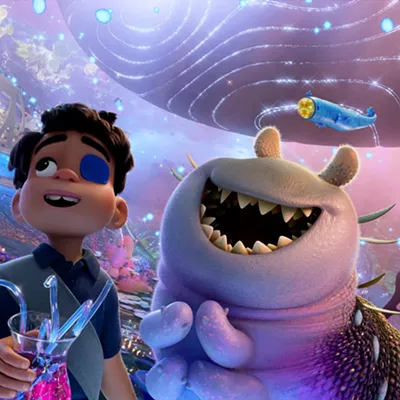The problem with the book was hammered
home for me when, after completing it, I immediately
reread the prologue, which convinced me that
Lehane lost his way with the ending. It’s a pity that
screenwriter Laeta Kalogridis and Scorsese couldn’t
come up with a different way to finish off the film.
Set in 1954 on a fictional island outside of
Boston Harbor, it’s the tale of federal marshals
Teddy Daniels (Leonardo DiCaprio) and Chuck
Aule (Mark Ruffalo), who are assigned to go to the
island’s one-of-a-kind hospital for the criminally
insane — which, they’re told, houses “the most dangerous,
damaged patients” — to search for a woman
who has not only escaped
from her escape-proof
cell, but disappeared.
That’s the whole
set-up and, indeed, the
whole story. But then the
film turns into a series of
personality studies, focusing
mostly on Teddy
(who has plenty of interior demons), Chuck (who
seems to be close to invisible even while we’re looking
right at him) and Ben Kingsley as head honcho
Dr. Cawley (a man of mystery and more than a hint
of a sinister edge).
The dilemma introduced by the patient’s escape
is compounded by Mother Nature in the form of a
hurricane that wraps its winds and rains around the
small island. Things get worse due to the resulting
communication breakdown between Shutter and the
mainland, as this all takes place four decades before
cell phones were everyday tools.
It’s when those things get worse that Scorsese
starts to make it all interesting. In revealing
the internal makeup of Teddy, he gives us a wide
spectrum of flashbacks. There are surreal, haunting
images of his marriage to Dolores (Michelle
Williams), who’s now gone
but keeps reappearing as
his voice of conscience; and
horrific ones lingering in his
memories of being a soldier and
taking part in the liberation of
Dachau.
The story keeps asking us if
this federal agent is in good enough
mental shape to be working in a place
that’s filled with people in very bad
mental shape.
Scorsese is aided by some outstanding production design from his regular collaborator Dante Ferretti (The Aviator, Gangs of New York), whose sets run from Dr. Cawley’s ridiculously lush living accommodations to the really creepy labyrinthine hallways and staircases in the hospital’s infamous Ward C. Oddly, Scorsese also makes use of some good old-fashioned rear screen projection, perhaps to better capture the flavor of the film’s ’50s timeframe.
As always, he gets some
of the best actors around.
There’s no point in discussing
DiCaprio, beyond
saying he’s once again terrific (although he drifts in
and out of a Boston accent; the only one who nails
it here is John Carroll Lynch as Deputy Warden
McPherson). Other great but brief performances
come from Robin Bartlett as a shaky patient named
Mrs. Kearns, and Patricia Clarkson, who will only
be revealed here as a woman in a cave. For the
record, the actor playing the sinister Andrew Laeddis
is not, as some people have hinted, Robert De
Niro. He’s the brilliant and underappreciated Elias
Koteas.
All kinds of dark secrets about the mental
health profession start to take center stage, as does
a descent into paranoia. There’s riveting stuff everywhere
you look. Too bad the ending isn’t more
concrete.















